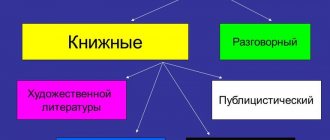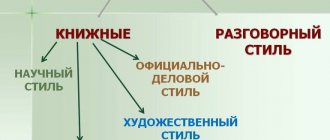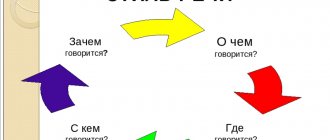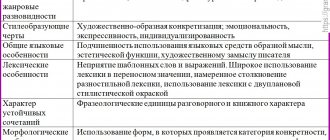- home
- Directories
- Handbook of Russian for elementary school
- Speech and its characteristics
- Speech styles
Speech style is the application of language style in a given speech area.
5 speech styles in Russian
- colloquial;
- art;
- journalistic;
- official business;
- scientific.
There are differences in the styles of oral and written speech. Oral speech includes conversational style, written speech includes all the others.
Each style has its own purpose, is used in a certain area and has certain characteristics by which they are distinguished.
Conversational style
This style of speech is used in everyday life, during informal communication with relatives, friends, and colleagues. This style is characterized by the use of addresses, words with suffixes of different colors (strength, mommy, etc.). The conversational style uses neutral words and colloquial words, jargon.
Art style
This style of speech is used in fiction. It uses epithets, words with a figurative meaning, figurative comparisons and figures of speech. This style especially expressively conveys emotions, feelings, and has a strong impact on the reader.
Journalistic style
Used in the media (in articles, essays, campaigning, speeches). This style also uses artistic expression to convey information to the reader. The style often uses incentive sentences, rhetorical questions (without answers) and exclamations.
Formal business style
Used in an official business environment for communication between citizens in institutions. The peculiarity of this style is accuracy and reliability of information. It contains many cliches of speech, words are used in their literal meaning, sentences for the purpose of the statement are narrative.
Scientific style
Used in the field of science, its purpose is to communicate scientific information. This style is characterized by a strict presentation of facts; words in a figurative sense, means of artistic expression and emotional coloring are not acceptable.
Share with friends on social networks:
What is style?
In the Russian language, words, figures of speech, phraseological units are characterized as neutral, solemn and reduced.
Most linguistic units belong to neutral, commonly used ones. They are the basis for all styles of the Russian language. The style is created based on a combination of neutral and specific linguistic means, characteristic only of this style of speech. The practice of using the Russian language in the process of its use in various spheres of public life has selected a certain set of linguistic means and forms of their implementation (genres) in accordance with the functions of the language:
- communication (communication);
- message (information);
- impact.
As a result of the functioning of the language, its varieties gradually emerged, belonging to a certain sphere of social life: politics, science, culture, business and everyday relations, etc. Each variety has special features, linguistic means and genres. From this point of view, let's define what style is:
Definition
Style is a type of literary language that is used in any area of public life and has its characteristic features, linguistic means and genres.
In the Russian literary language, the following speech styles are distinguished:
- scientific style;
- journalistic style;
- official business style;
- art style;
- conversational style.
Each style of speech has distinctive features:
- scope of application;
- goal (speech task);
- style features;
- language means;
- genres.
| Style | Scope of use | Genres | Language means |
| Scientific | Science, technology, education | Scientific article, monograph, textbook, abstract, report, etc. | Abstract nouns, terms, complex syntax, etc. |
| Journalistic | Mass media | Essay, article, note, interview, essay, report, feuilleton | Socio-political vocabulary, expressive vocabulary, phraseological units, evaluative vocabulary |
| Official business | Legislation, office work | Legislative documents (constitution, charter, code), business papers (order, agreement, etc.) | Official and clerical vocabulary, standard expressions, impersonal sentences |
| Art | Fiction | Novel, story, story, poem, poem, play, etc. | Wide use of figurative means, exclamatory, interrogative sentences |
| Colloquial | Everyday communication | Everyday conversation, request, personal letter, telephone conversation, compliment, etc. | Colloquial and colloquial vocabulary, emotional and evaluative words, incentive sentences, appeals, direct speech |
From this point of view, we will consider each speech style of the Russian literary language.
The essence and types of communication
Definition 1
Communication is a complex, multifaceted process of establishing and developing contacts between individuals or groups of people, generated by their needs for joint activities and including three components: communication, interaction and perception.
Within the framework of communication, scientists identify three interconnected parties:
- Communication side (exchange of information between individuals);
- Interactive side (organization of interaction between individuals);
- The perceptual side (communication partners’ perception of each other, the formation of mutual understanding on this basis).
In the specialized literature one can see many different approaches to the classification of types of communication. In particular, based on the position of those communicating in communication, the following are distinguished:
Are you an expert in this subject area? We invite you to become the author of the Directory Working Conditions
- business conversation,
- formal or role communication,
- primitive communication,
- interpersonal communication,
- manipulative communication,
- secular communication.
Scientific style
The name of this style clearly indicates its scope in public life. If you open any textbook, reference book, encyclopedia or scientific work (monograph, dissertation, report, abstract, annotation, etc.), we will find out that the text is presented in the scientific style of literary language.
With the help of a scientific style of speech, the goal is realized - to communicate information. This style is characterized by emphasized logic . Important stylistic features are accuracy and evidence communicating
In scientific texts, uncertainty or ambiguity is not possible. The scientific style is characterized by an abundance of terms as words that do not have multiple meanings. Along with terms, abstract nouns are widely used, and complex sentences are also in demand. Scientific texts lack emotion or expressiveness.
Let's see this by reading an example of a scientific style test:
The process of merging several peoples or individual significant groups into one large nation and its further ethnic unity with economic and cultural development is called consolidation. Another very common ethnic process at present is assimilation, which consists in the absorption by one people of small, usually disunited groups of other peoples; assimilation processes are most characteristic of developed multinational countries with a mass settlement of immigrants (USA, Canada and other American countries, Australia, France, etc.)
Directory "World Population"
Description
Description is an image of a phenomenon of reality, an object, a person by listing and revealing its main features.
The purpose of description in a literary text is to convey impressions about an event, object, phenomenon, person, and to create a general image by focusing on details. The purpose of the description is for the reader to see the subject of the description and imagine it in his mind.
The description can be used in any style of speech, but in a scientific one, the description of the subject must be extremely complete, and in an artistic one, the emphasis is on the most striking details.
- Scientific description: Purple ranet apple tree is a frost-resistant variety. The fruits are round in shape, 2.5-3 cm in diameter. Fruit weight is 17-23 g. Average juiciness, with a characteristic sweet, slightly astringent taste.
- Artistic description: The linden apples were large. If you look through the apple into the sun, it shines through like a glass of fresh linden honey.
In texts of a scientific or business nature, using a description, they indicate the purpose of a particular object, methods, sphere, features of functioning, belonging to a certain category, type, class.
Structure of detailed descriptive texts:
- subject – portrait of a hero, landscape, interior, object of study, situation;
- detailing - characteristics of individual parts that add up to the overall picture;
- general idea, complete picture.
The text can begin or end with a general representation of the object being described. Portrait and interior descriptions are usually static: moving from one detail to another, the author completes the overall picture. Landscape descriptions can be dynamic, when individual objects of the overall picture appear in the field of view and are described as they move.
Examples of text - descriptions
- Portrait. At that moment the owner came in with a boiling samovar; I offered our counselor a cup of tea; the man got off the floor. His appearance seemed remarkable to me: he was about forty, average height, thin and broad-shouldered. His black beard showed streaks of gray; the lively big eyes kept darting around. His face had a rather pleasant, but roguish expression. The hair was cut into a circle; he was wearing a tattered overcoat and Tatar trousers.
- Scenery. But as soon as Vladimir drove out of the outskirts into the field, the wind rose and there was such a snowstorm that he could not see anything. One minute the road skidded; the surroundings disappeared into a muddy and yellowish haze, through which white flakes of snow flew; the sky merged with the earth.
- Interior. The rooms of the house in which our old people lived were small, low, such as are usually found among old-world people. Each room had a huge stove, occupying almost a third of it. These rooms were terribly warm, because both Afanasy Ivanovich and Pulcheria Ivanovna loved warmth very much.
In literary texts, the description of details involves the use of visual means:
- lexical:
- epithet (figurative definition) - golden foliage, heavy impression;
- metaphor (implicit comparison) - angelic face, silent streets;
- hyperbole, litotes, comparison and other tropes - scared to death, quieter than water, like a frightened bird;
- colloquial, expressive vocabulary and others: lackey look, blond bangs;
- syntactic:
- rows of homogeneous members of a sentence - he was embarrassed, hid his trembling, tired hands, looked away and sighed heavily;
- direct or reverse word order - a tall, erect trunk, an arrogant, shameless look;
- compound nominal predicates - his hands were strong, his gait was confident, his gaze was fixed;
- morphological (timeless use of verbs in the present, past tense) - It was a long time ago, but I remember clearly. The day is warm and gentle, the leaves are barely moving, the birds have fallen silent from the heat.
Journalistic style
Journalistic style is a type of literary language that is used by the media (television, radio, newspapers, magazines, etc.) to communicate important information in the world of politics, national economy, culture, as well as influence readers and listeners in order to form them from a certain point of view.
This style is used in periodicals, socio-political literature, in speeches and speeches at rallies, election campaigns, congresses, etc. Let us indicate its characteristic stylistic features:
- emotionality
- relevance
- use of appeals
- brightness
In journalistic style texts, along with neutral ones, socio-political vocabulary, speech journalistic stereotypes, rhetorical questions, appeals, and incentive sentences are widely used.
Example
According to the results of the last vote in the parliamentary elections, the Social Democratic Party of Germany (SPD) became a contender for the Bundestag, which narrowly beat Angela Merkel's CDU/CSU party. Olaf Scholz (from the SPD party) is considered the main candidate for the post of chancellor.
Narration
A narrative is a type of text that describes events in a specific sequence.
The purpose of narration in the text is to convey a series of events, information about the sequential development of action. The expanded narrative text is built according to the following scheme:
- the plot is the event from which it all began, the reason why the chain of interconnected actions unfolded further;
- development with or without culmination: listing the main stages, the relationship of key points;
- denouement is the last link in the chain of events.
Example text - narrative
At ten o'clock in the morning both armies met with a rifle shot, and fire opened along the entire line. The troops then rushed hand to hand; the first clash occurred on the left flank of the Russian infantry, the right flank of the Swedish infantry, inspired by the presence of the king, rushed at the Russians and overthrew the battalion of the Novgorod regiment; there was a gap in our line. Peter the Great, noticing the danger, took the second line battalion and personally led it against the enemy.
The dynamic nature of the presentation, change of actions, sequential logic of presentation (chronology) are the features of narrative texts. This effect is achieved through the use of the following grammatical means:
- simple or compound verbal predicates;
- the type and tense of verbs correspond to the logic of the narrative;
- homogeneous predicates;
- direct word order in a sentence.
Formal business style
The official business style is in demand in the written execution of various documents. Its main task is to communicate information. This style of speech is used when writing laws, decrees, orders, certificates, reports, statements, announcements, instructions, protocols, powers of attorney, etc.
The official business style is characterized by a preliminary selection of linguistic means, which consists of the use of ready-made standard expressions, cliches, verbal nouns (instruction, decree, violation, action), words with the meaning of obligation (necessary, necessary, obligatory, should, obliged, etc.). ).
Expressive language means are not used in writing documents. In the preparation of documentation, impersonal or vaguely personal sentences are widely used. This style of speech is quite conservative. It is characterized by historically established genres and figures of speech that hardly change over time.
Example
Citizens are obliged:
comply with the requirements of the sanitary law, as well as regulations and instructions carrying out federal state sanitary and epidemiological supervision of officials;
take care of the health, hygienic education and education of their children;
not to carry out actions that entail a violation of the rights of other citizens to health protection and a favorable living environment.
(Federal Law on the Sanitary and Epidemiological Welfare of the Population).
Art style
Artistic style is realized in the works of writers and poets. The purpose of artistic style is to influence the feelings and thoughts of readers with the help of vivid images created by a master of words.
Just like other styles of speech, it is based on neutral vocabulary and at the same time combines the linguistic means of other styles, and not only. To make the reader’s perception multifaceted and vivid, the word artist uses emotionally charged vocabulary, as well as words of a limited scope of use (dialectisms, professionalisms) and even vernacular words.
The imagery and expressiveness of the artistic style of speech are created by tropes and stylistic figures of speech: metaphors, epithets, personifications, hyperboles, comparisons, allegories, anaphors, epiphoras, etc. These linguistic means increase the possibility of an objective reflection of reality, enhance the emotional background of the work and at the same time help figuratively and concisely convey the essence of a character, phenomenon, event.
The artistic style is in demand in prose, poetry and drama, where there are certain genres:
- tragedy, comedy, drama, farce;
- novel, story, short story, short story;
- poem, poem, ode, fable, romance, etc.
Let us illustrate the artistic style with an excerpt from the work of writer A. Kuprin:
The air is filled with a strong and delicate aroma of fading maples, similar to the smell of good wine. Yellow, dead leaves rustle underfoot, covering the path in a thick layer. The trees were decorated colorfully and brightly, as if for a dying feast. The remaining green branches here and there are intricately mixed with autumn tones, sometimes light lemon, sometimes fawn, sometimes orange, sometimes pink and bloody, sometimes turning into colors of lilac and purple. The sky is empty and cold, but its cloudless blue pleasantly caresses the eye.
Test on the topic
- /10
Question 1 of 10How many functional styles are usually distinguished in the Russian language?
Start test
Hall of Fame
To get here, take the test.
- Marufjon Ganiev
10/10
- Nikita Gavrilin
8/10
- Sergey Pisarenko
7/10
- Andrey Romanov
7/10
Conversational style
Conversational style is the language of casual communication. It is used as a means of communication, establishing direct contact between speakers or writers.
Conversational style mainly belongs to oral speech. It is used in everyday and casual professional relationships.
This style of speech is characterized by informality, the absence of a preliminary choice of linguistic means, as well as the widespread use of extralinguistic methods of communication, such as gestures and facial expressions.
The main language means is colloquial vocabulary, nouns with evaluative suffixes (aunty, baby), words with reduced coloring (get into trouble, go nuts).
The conversational style is characterized by an abundance of interrogative, imperative and exclamatory sentences, truncated turns of speech, and incomplete sentences.
The conversational style of speech is implemented in informal conversation, private conversation, telephone communication, personal correspondence, and diary entries.
Example
Hello, dear friend Svetochka!
I hasten to report that I quickly reached my aunt in the village. It's so cool here! I can finally sleep as much as I want. You just drink in sips of fresh air, and there is a river nearby. In such stuffy conditions, this is simply salvation. I can’t imagine how you live there in this concrete jungle! Pack your belongings and come and relax on your day off. You will not regret!
Yours Nadya.
Although freedom of choice of linguistic means is allowed in colloquial speech, nevertheless this style of speech is an undoubted component of the Russian literary language.










